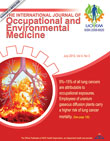فهرست مطالب

International Journal of Occupational and Environmental Medicine
Volume:4 Issue: 3, Jul 2013
- تاریخ انتشار: 1392/05/09
- تعداد عناوین: 7
-
-
Page 113Hazardous chemicals may enter the body by inhalation, ingestion, injection or dermal absorption. These exposure routes constitute the overall exposure burden on the body. Most occupational exposure studies have focused on measurement of the concentration of air-borne contaminants and other possible routes of exposure are often overlooked.Several studies have already highlighted the importance of dermal absorption. However, less development occurred in the assessment of dermal exposures to occupational and environmental contaminants compared to air sampling techniques.This paper intends to highlight the importance of dermal exposure and looks at the methods currently used for its assessment. Advantages and disadvantages of each method in the context of occupational dermal exposure assessment are also outlined. Dermal exposure models, as an easy-to-use and low-cost tool to predict dermal uptake, especially when few or no actual data are available, are also included in this review.
-
Page 128Background9%–15% of all lung cancers are attributable to occupational exposures. Reports are disparate regarding elevated lung cancer mortality risk among workers employed at uranium gaseous diffusion plants.ObjectiveTo investigate whether external radiation exposure is associated with lung cancer mortality risk among uranium gaseous diffusion workers.MethodsA cohort of 6820 nuclear industry workers employed from 1952 to 2003 at the Paducah uranium gaseous diffusion plant (PGDP) was assembled. A job-specific exposure matrix (JEM) was used to determine likely toxic metal exposure categories. In addition, radiation film badge dosimeters were used to monitor cumulative external ionizing radiation exposure. International Classification for Disease (ICD) codes 9 and 10 were used to identify 147 lung cancer deaths. Logistic and proportional hazards regression were used to estimate lung cancer mortality risk.ResultsLung cancer mortality risk was elevated among workers who experienced external radiation >3.5 mrem and employment duration >12 years.ConclusionEmployees of uranium gaseous diffusion plants carry a higher risk of lung cancer mortality; the mortality is associated with increased radiation exposure and duration of employment.
-
Page 141BackgroundEmotion and how people manage it is an important part of personality that would immensely affect their health. Investigations showed that emotional intelligence is significantly related to and can predict psychological health.ObjectiveTo determine the effect of teaching emotional intelligence to intensive care unit nurses on their general health.MethodsThis randomized clinical trial (registered as IRCT201208022812N9) was conducted on 52 of 200 in intensive care unit nurses affiliated to Shiraz University of Medical Sciences. They were recruited through purposeful convenience sampling and then randomly categorized into two groups. The intervention group members were trained in emotional intelligence. Bar-on emotional intelligence and Goldberg''s general health questionnaires were administered to each participant before, immediately after, and one month after the intervention.ResultsWhile the mean score of general health for the intervention group decreased from 25.4 before the intervention, to 18.1 immediately after the intervention and to 14.6 one month later, for the control group, it increased from 22.0, to 24.2 and to 26.5, respectively (p<0.001).ConclusionTeaching emotional intelligence improved the general health of intensive care unit nurses.
-
Page 149BackgroundWith the fast growth in the market of fluorescent lamps، particularly compact fluorescent light، the associated risk of mercury exposure، which is an essential component in all types of fluorescent lamps، has received increasing public attention worldwide. Even low doses of mercury are toxic.ObjectiveTo study the health consequences of occupational exposure to mercury in workers of a fluorescent lamp factory.MethodsIn a cross-sectional study 138 workers of a florescent lamp factory and 151 people who had no occupational exposure to mercury (the comparison group) were studied. Environmental study of mercury and noise levels was done. For all participants a neurobehavioral test battery was administered، spirometry was performed and air conduction audiometry was done. Urinary mercury level was also measured for all participants.ResultsProminent symptoms among workers exposed to mercury included tremors، emotional lability، memory changes، neuromuscular changes، and performance deficits in tests of cognitive function. Among the exposed group، the mean urinary mercury level was significantly higher in those who had personality changes or had manifestations of mercury toxicity. With increasing duration of employment and urinary mercury level، the performance of participants in neurobehavioral test battery and spirometric parameters deteriorated.ConclusionNeurobehavioral test battery must be used for studying subclinical central nervous system dysfunction in those with chronic exposure to mercury. The test is especially useful for evaluating the severity of mercury effects in epidemiological studies. This study also reinforces the need for effective preventive programs for florescent lamp industry workplaces especially in developing countries with the lowest unhygienic work conditions.
-
Page 157BackgroundNational Transport Commission (NTC) classifies train driving as a high-level safety critical job.ObjectiveTo assess fitness-for-work among train drivers in Yazd, central Iran.MethodsWe evaluated 152 train drivers for their fitness for duty. The results were then compared with NTC guidelines.Results63.8% of subjects were fit for duty, 34.2% fit subject to review, and 2.0% were temporarily unfit. The most common reason for fit subject to review was a Kessler score >19. The prevalence of overweight and obesity was 48.0% and 15.0%, respectively. The prevalence of dyslipidemia was 69.7%, diabetes 10.0%, impaired fasting glucose 36.0%, and hypertension was 19.0%, respectively.ConclusionMost studied train drivers can continue their work safely. The prevalence of some risk factors such as overweight and dyslipidemia were high among train drivers. This warrants further evaluation and establishment of control programs.
-
Page 164The isocyanates are widely used as precursors of polyurethane products, as well as carbamate insecticides. Toluene 2,4-diisocyanate (TDI) is one of the most important commercially used isocyanates. Humans may be exposed to TDI by inhalation, ingestion, dermal and eye contact. TDI is a powerful irritant to the mucosal membranes of the gastrointestinal and respiratory tracts, eyes and the skin. Pulmonary manifestations, especially occupational asthma, are the predominant manifestations after TDI toxicity. Herein, we present intestinal obstruction as an extraordinary manifestation of acute TDI toxicity after occupational exposure. TDI toxicity may cause intestinal obstruction.


